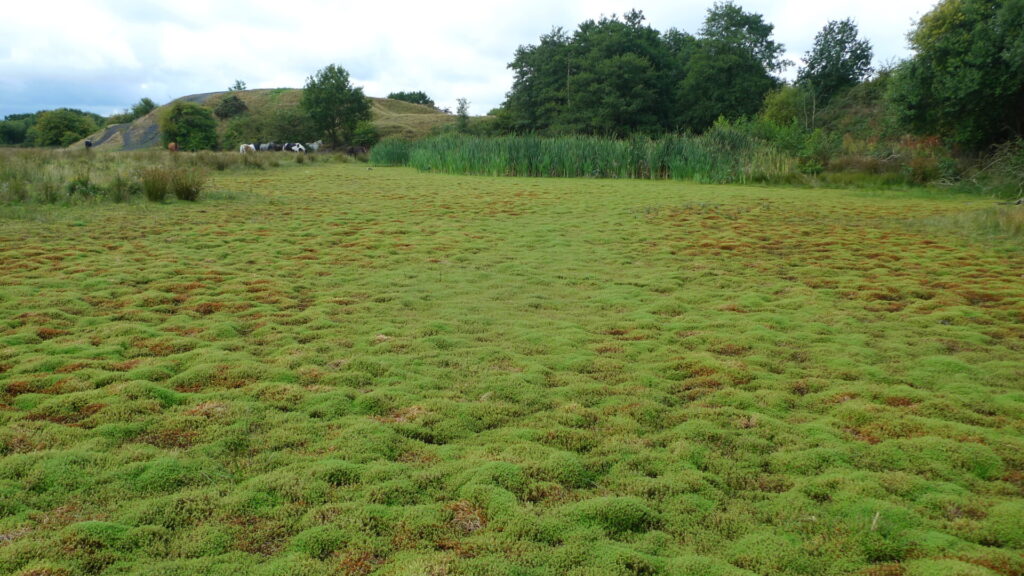
The Crassulaceae or Stonecrop family looks ornamental most of the year because of its rounded, succulent and evergreen foliage. However, the flowers give it an extra attraction!
I always associated this family with drought loving plants but I learned it has several moisture loving members too!
The flowers are providing food as well as shelter for many types of insects.
Several of the genera and species mentioned in Stace are in fact ornamental garden plants and have ‘escaped’ into the wild as often happens! At least one species of Crassula is now a serious weed, originally introduced as an aquatic ornamental for ponds.
Thanks for pictures donated by Mike Poulton of Ecorecord as well as from Wikipedia Commons. If there is no picture, you will see what it looks like by pressing the link below the (common) Name. Also pictures in the Gallery of the Plant Atlas Online, which you can find pressing the link on the Scientific Name.
Any Crassulaceaes found in the Flora of Birmingham & Black Country will have FBBC next to the plant in the contents below.
A blue background tells you about the habitat where it can be found in B.I. as well as for interesting facts or wildlife use! A pink background means a warning (such as poisonous!) or medicinal use, green for edible, ornamental or other uses.
Contents:
Crassula or Pigmyweeds:
C. tillaea or Mossy Stonecrop
C. aquatica or Pigmyweed
C. helmsii or New Zealand Pigmyweed FBBC
C. decumbens or Scilly Pigmyweed
C. pubescens or Jersey Pigmyweed
Umbilicus rupestris or Navelwort
Sempervivum spp or House-leeks
Sempervivum tectorum or House-leek FBBC
S. arachnoideum or Cobweb House-leek
Aeonium cuneatum or Aeonium
Aeonium arboreum ‘Atropurpureum’ or Dark Purple Houseleek Tree
Rhodiola, Hylotelephium, Sedum spp., Petrosedum, more Sedum spp. and Phedimus or Stonecrops:
Rhodiola rosea ( syn. Sedum rosea) or Roseroot FBBC
Hylotelephium spectabile or Butterfly Stonecrop FBBC
Hylotelephium telephium or Orpine FBBC
Sedum acre or Biting Stonecrop FBBC
S. album or White Stonecrop FBBC
S. anglicum or English Stonecrop
S. villosum or Hairy Stonecrop
S. praealtum or Greater Mexican-stonecrop FBBC
Petrosedum forsterianum or Rock Stonecrop FBBC
P. rupestre or Reflexed Stonecrop FBBC
P. sediforme or Pale Stonecrop
Sedum dasyphyllum or Thick-leaved Stonecrop
- S. anacampseros or Love-restoring Stonecrop
- S. hispanicum or Spanish Stonecrop
- S. kimnachii or Lesser Mexican-stonecrop
- S. lydium or Least Stonecrop
- S. spathulifolium or Colorado Stonecrop FBBC
- S. sexangulare or Tasteless Stonecrop FBBC
Phedimus stellatus or Starry Stonecrop
P. kamtschaticum or Kamchatka Stonecrop FBBC
P. spurius or Caucasian-stonecrop FBBC
P. stoloniferus or Lesser Caucasian Stonecrop
Crassula or Pigmyweeds

Crassula is a genus of succulent plants containing about 200 accepted species, including the popular jade plant (Crassula ovata). Cultivated varieties originate almost exclusively from species from the Eastern Cape of South Africa.
Stace describes the 5 species found on the B.I. below:
C. tillaea or Mossy Stonecrop
A tiny annual, growing on bare, often compacted, sandy or gravelly ground.
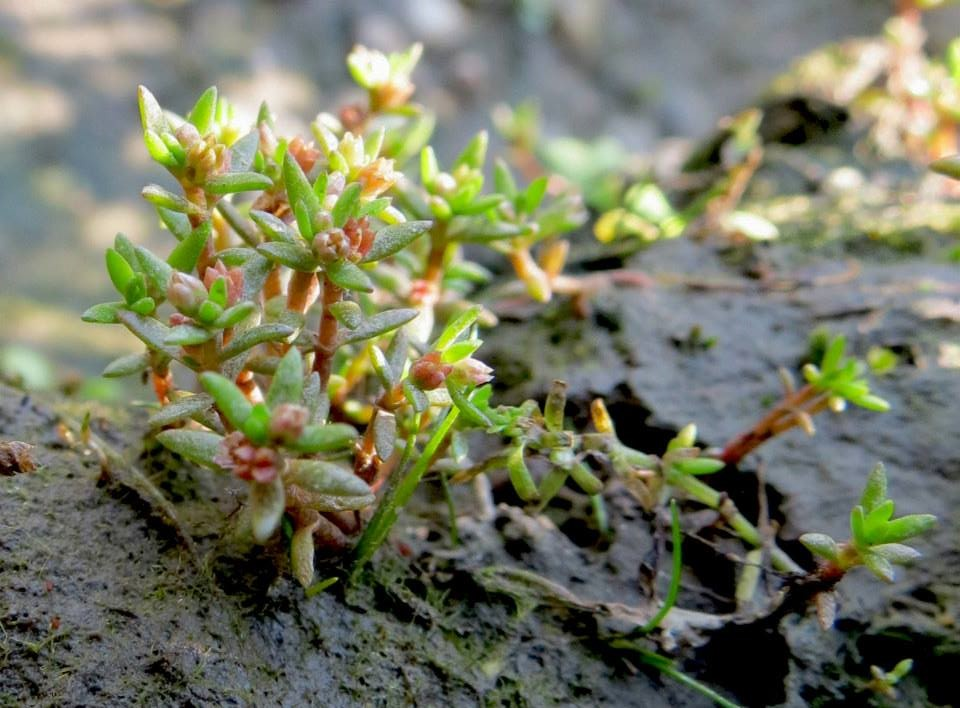
C. aquatica or Pigmyweed
A small, slender annual which is currently known from only one locality. It grows in shallow water or on wet mud exposed by fluctuating water levels at the side of the River Shiel (Westerness), and on damp peaty soil where the riverside vegetation has been disturbed.
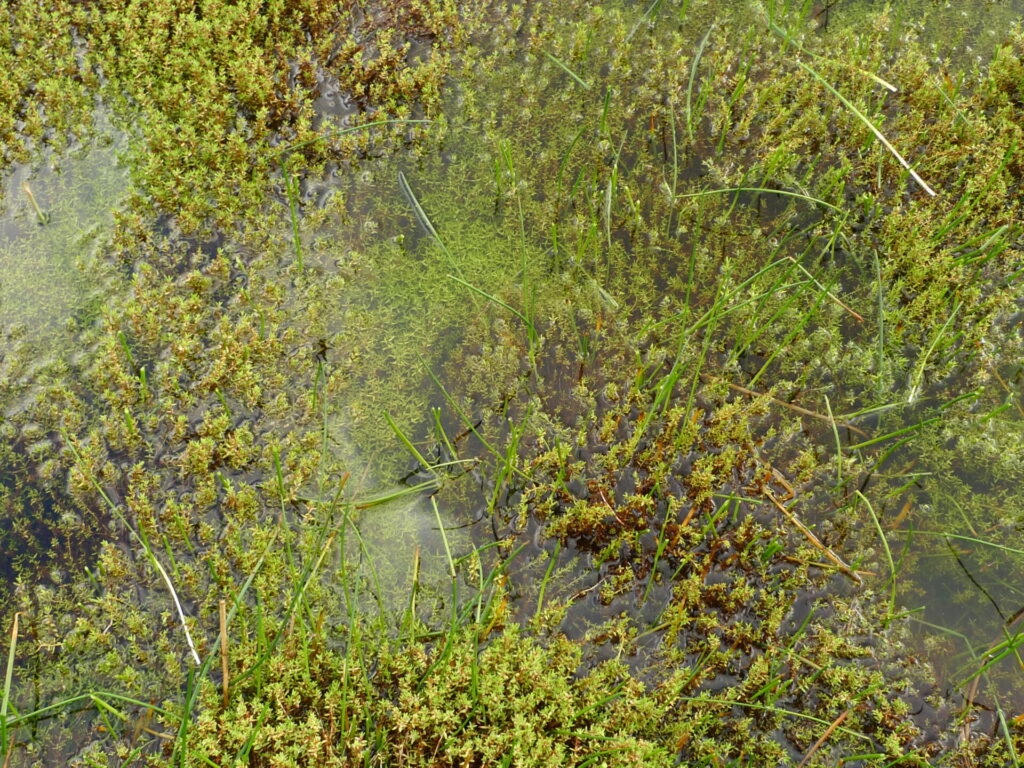
C. helmsii or New Zealand Pigmyweed
This perennial herb grows submerged in sheltered waters up to 3 metres deep or as an emergent on damp ground. It grows on soft substrates in a variety of habitats, including ponds, lakes, reservoirs, canals and ditches and can tolerate a wide range of water chemistry. It can form dense, virtually pure stands.
This aggressively colonising species was first cultivated in Britain in 1927 and was discovered in the wild in 1956 (Greensted, Essex). Originally found in Australia and New Zealand, it has been introduced around the world. In the United Kingdom, this plant is one of five introduced invasive aquatic plants that were banned from sale from April 2014, the first ban of its kind in the country. It is on the Global Register of Introduced and Invasive Species of eleven countries.
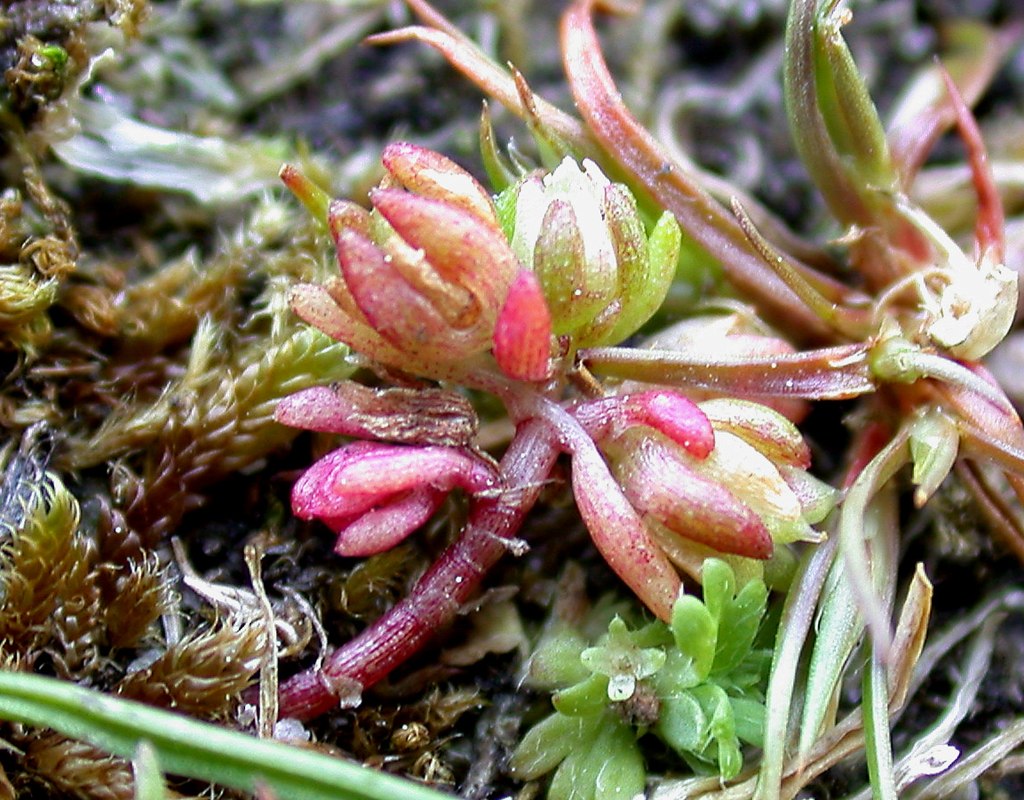
C. decumbens or Scilly Pigmyweed
An annual neophyte found naturalised in damp, sandy bulbfields and by tracks on St Mary`s (Isles of Scilly), and elsewhere as a casual from wool shoddy.
C. pubescens or Jersey Pigmyweed
A stoloniferous perennial herb with succulent leaves, naturalised in sandy soil at the base of a granite boulder on Jersey (Channel Islands). Reproduction is by rooting of detached leaves; no seed is produced. This neophyte species has been known from the wild in Jersey since 1970.
The exact identity of our plant is uncertain; it may be C. pubescens subsp. radicans.

Umbilicus rupestris or Navelwort
This is an interesting looking plant. Both the name “navelwort” and the scientific name Umbilicus come from the round shape of the leaves, which have a navel-like depression in the center.
It is a perennial herb, growing on walls, in rock crevices and on stony hedge banks, mainly on acidic substrates. In Cornwall it has even been seen growing as an epiphyte on the boughs of large trees.
Navelwort is assumed to be the “Kidneywort” referred to by Nicholas Culpeper in The English Physician.
- Vulnerary: The plant is sometimes employed to ease pain on scratches by applying the leaf to the skin after removing the lower cuticle.
- Umbilicus rupestris is used in homeopathic medicine and goes under the name of Cotyledon umbilicus when used by Homeopaths.
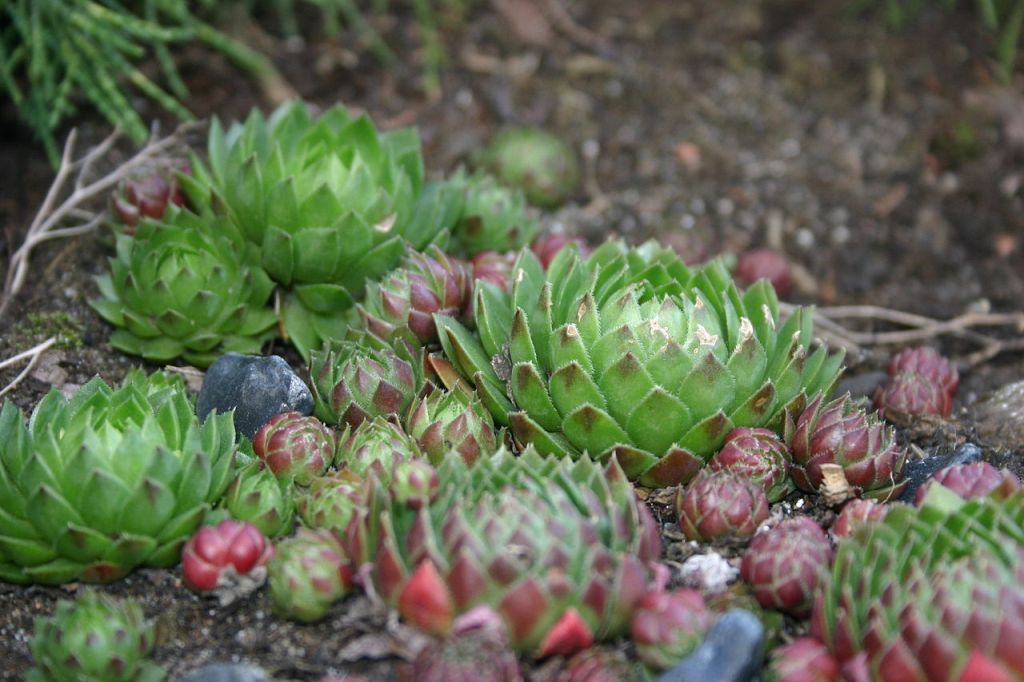
Sempervivum spp or House-leeks
These are interesting and attractive, but mostly introduced succulents for rockeries or pots and shallow pans. None are natives though!
It is a long-lived, evergreen perennial, planted and more or less naturalised on tiled and thatched roofs, old walls, gate pillars and porches, and in churchyards.
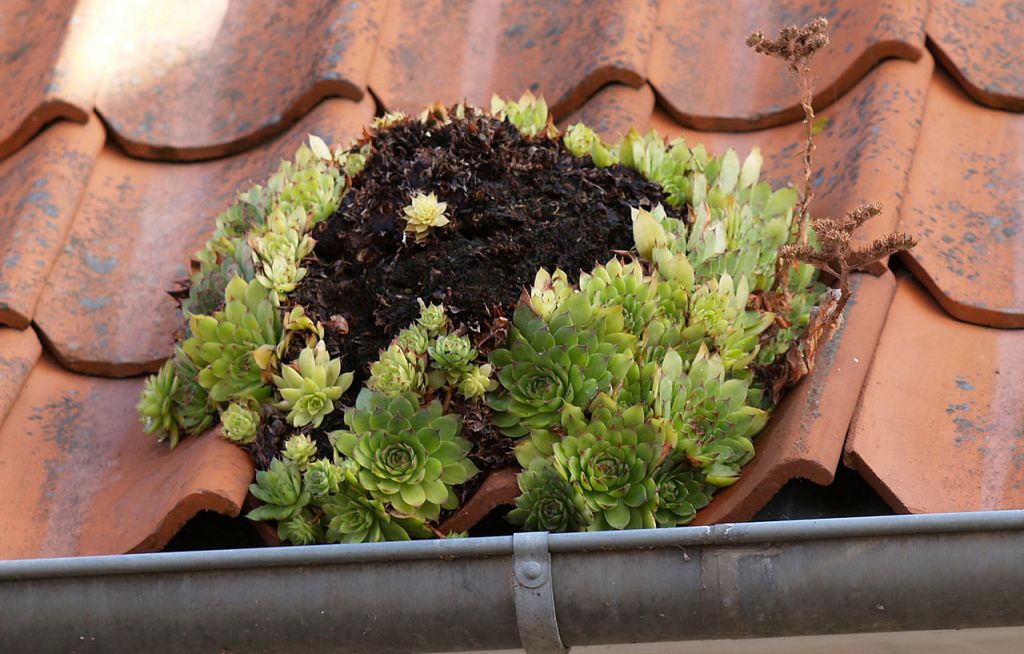
Sempervivum tectorum or House-leek
S. tectorum has been grown in gardens since at least 1200 (Harvey, 1981), and was often planted on porches and roofs as a supposed protection against fire, lightning and thunderbolts. It was known in the wild by 1629.
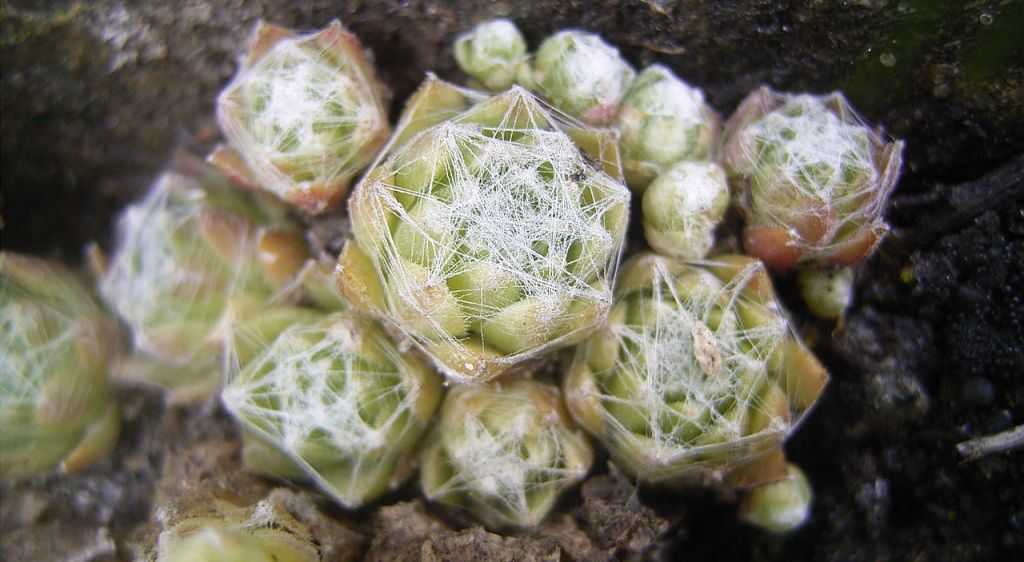
Sempervivum arachnoideum or Cobweb House-leek
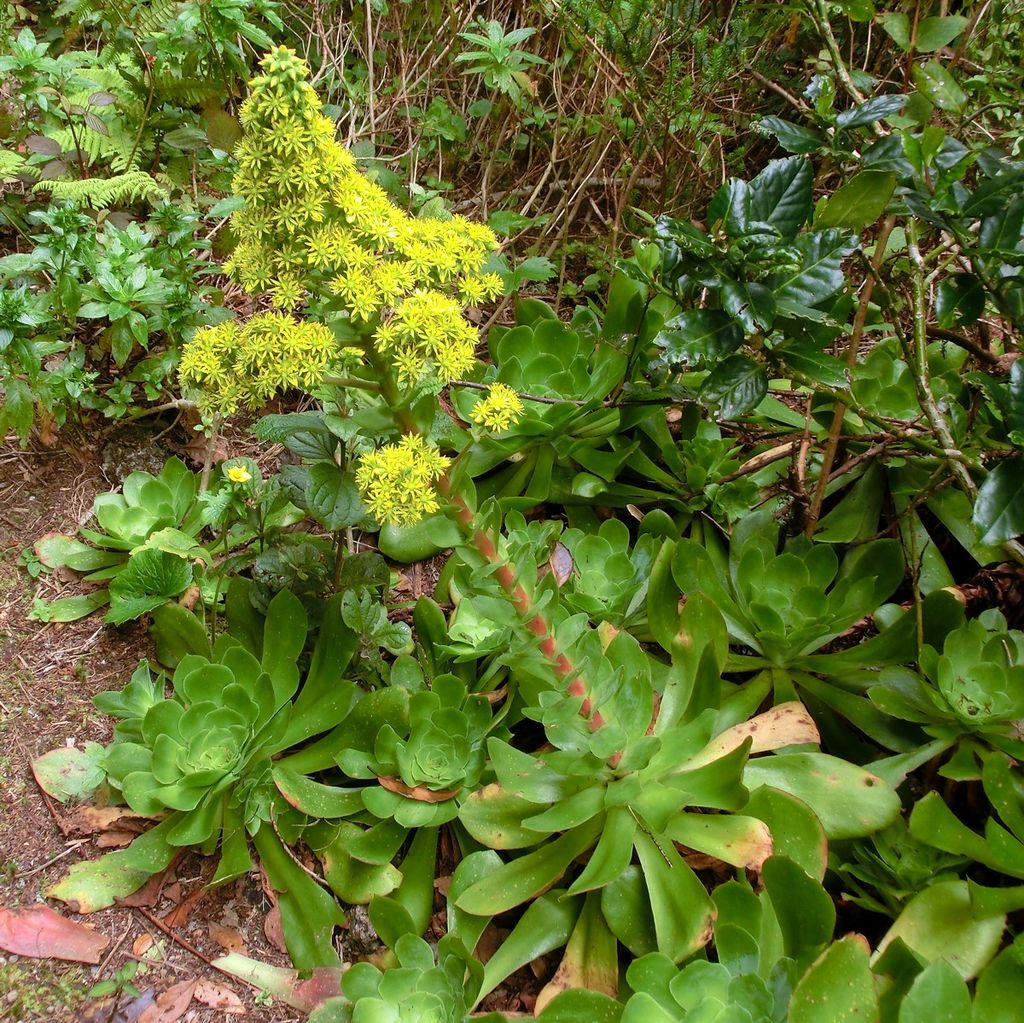
Aeonium cuneatum or Aeonium
This is clearly not a native, but can be seen growing on walls in the SW and Scilly Isles.
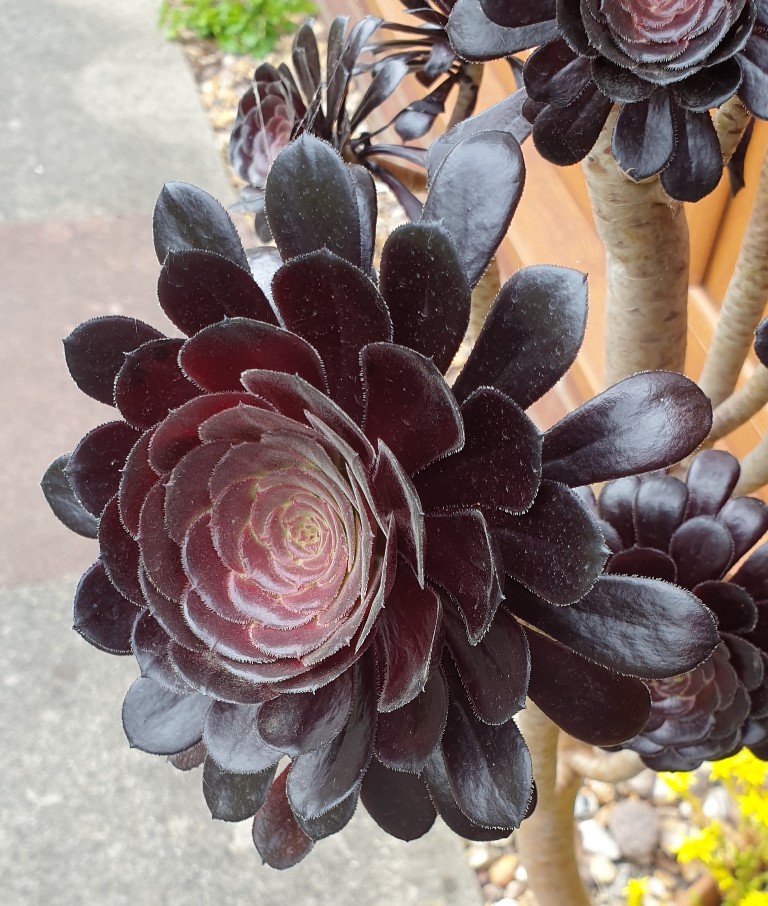
Aeonium arboreum ‘Atropurpureum’ or Dark Purple Houseleek Tree
This is a dramatic looking exotic, splendid for a colourful display!
Sedum spp. , Rhodiola, Hylotelephium, Phedimus and Petrosedums or Stonecrops:
There are 23 species of Sedum described in Stace which are split into 6 sections. A few genera of Sedum have been renamed into another genus. Many are grown as ornamental, rockery plants.
They are also used on so called ‘Green Roofs’ , which are beneficial in themselves but the flowers benefit insects as well for their nectar and the fact the places they grow often provide a sunny habitat.
The most common or/and native ones are:
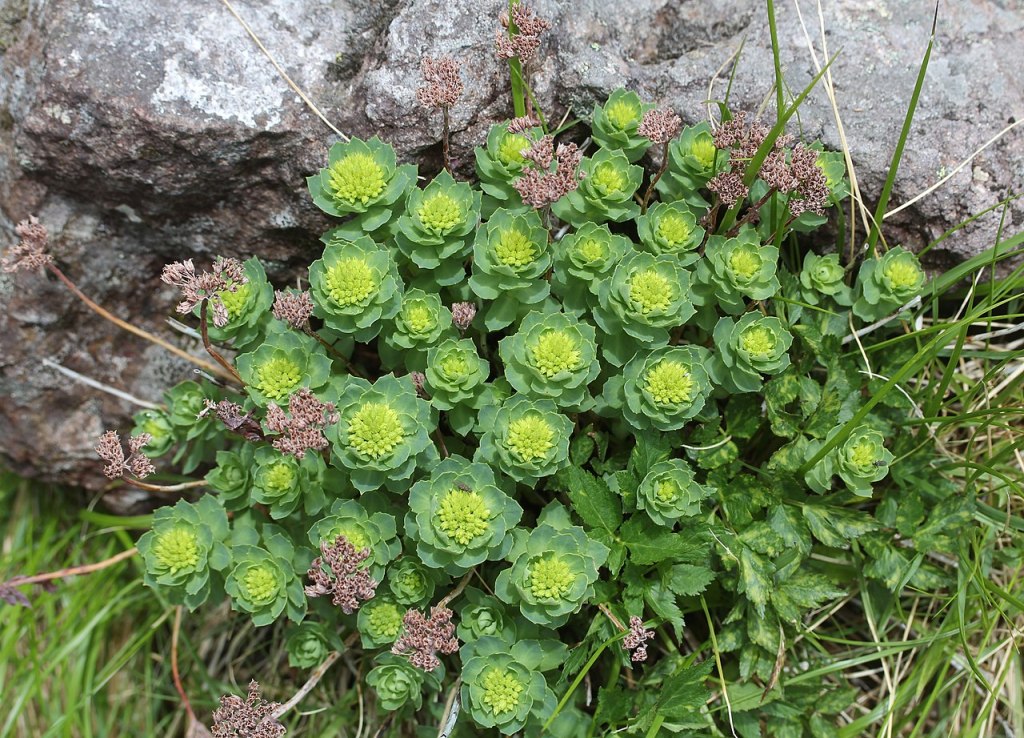
Rhodiola rosea ( syn. Sedum rosea) or Roseroot
A rhizomatous perennial herb which grows on sea-cliffs and in mountains in rock crevices and on moist rock ledges. Very rarely, in W. Ireland, it occurs on coastal limestone pavement. In montane habitats it usually occupies sites which are at least slightly base-enriched.
The leaves and shoots are eaten raw, having a bitter flavor, or cooked like spinach, and are sometimes added to salads. An extract is sometimes added as a flavouring in vodkas.
In Russia and Scandinavia, S. rosea has been used for centuries to cope with the cold Siberian climate and stressful life. It is also used to increase physical endurance and resistance to high-altitude sickness, but the scientific evidence for such benefits is weak. The plant has been used in traditional Chinese medicine, where it is called hóng jǐng tiān.
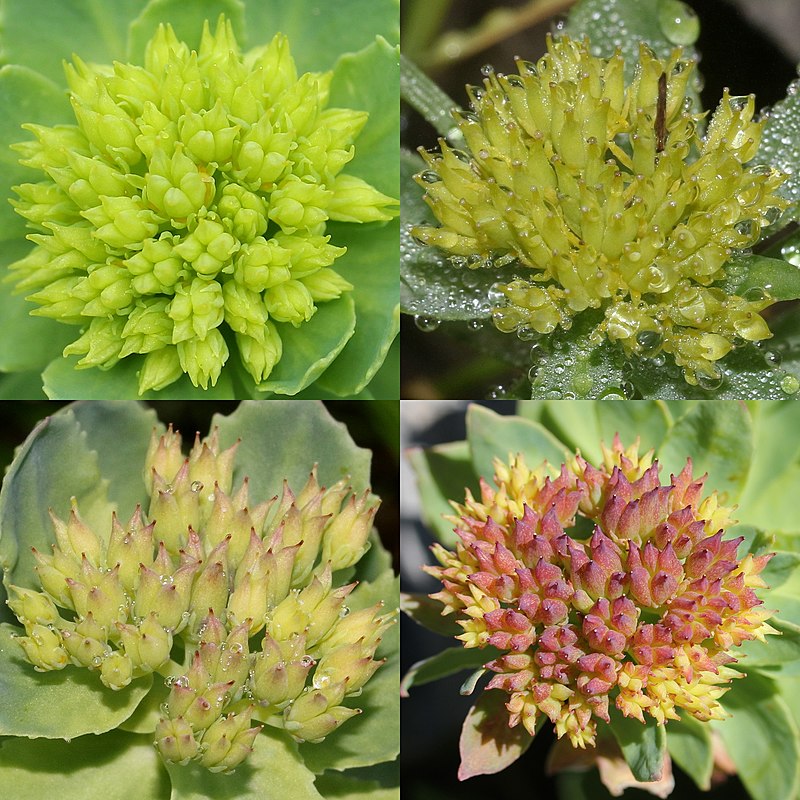
It was previously grown as a source of perfume extracted from the roots, and is occasionally recorded as a garden escape.
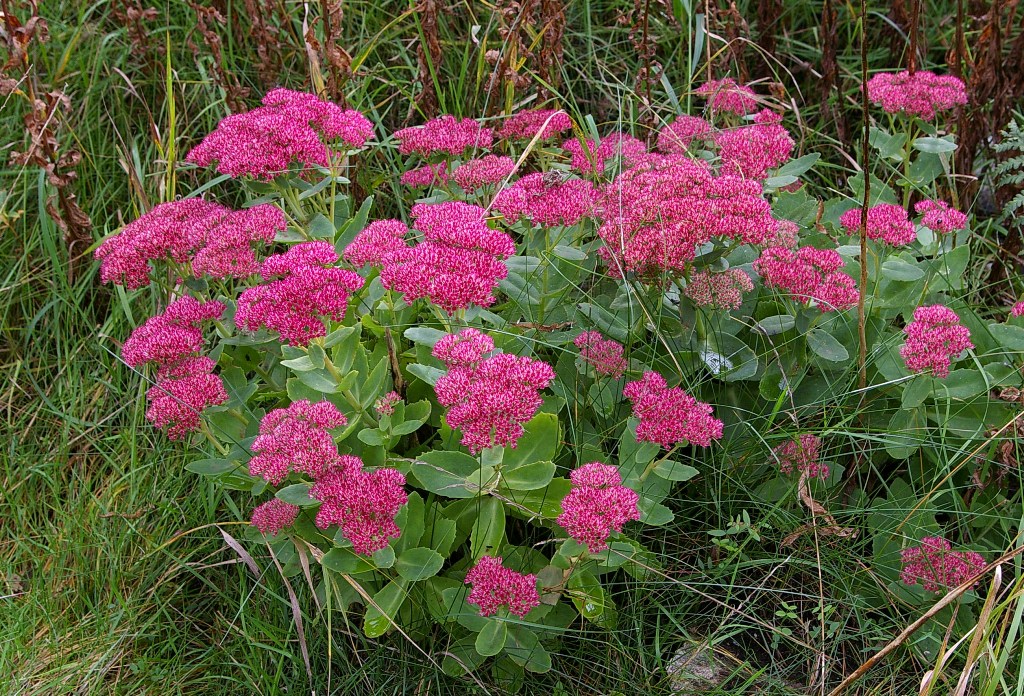
Hylotelephium spectabile or Butterfly Stonecrop
A succulent, clump-forming perennial herb, widely grown in gardens and found well-naturalized in woodland and on roadsides, waste ground, disused railways and refuse tips, having originated as a garden throw-out, establishing itself from the smallest fragment.
H. spectabile is valued in cultivation, and numerous cultivars have been produced. The species and the cultivar ‘Brilliant’ have both gained the Royal Horticultural Society‘s Award of Garden Merit.
Hylotelephium telephium or Orpine
A perennial herb of wood-borders, scrub, hedgebanks, rough grassland, roadsides, rocky banks and limestone pavement, often in very small but very persistent colonies. It also occurs as an uncommon ancient woodland plant, but sometimes fails to flower in this habitat.
The very young leaves can be eaten raw, and both the young leaves and firm tubers can be cooked.
The plant has been used medicinally, being used by the Romans to treat wounds, and in later times to treat internal ulcers. It has also been used for love-divination. As the stems and leaves can store water, when picked. Hence common name livelong. They were hung in a room, where a girl was to be married to a boy. If the stems grew together, this ‘sign’ would mean that the marriage would be blessed and she would be happy. Alternatively, if they grew apart, the marriage prospects looked bad and if a stem died, this would portent death.
The flowers are held in dense heads and can be reddish or yellowish-white. A number of cultivars, often with purplish leaves, are grown in gardens as well as hybrids between this species and the related Hylotelephium spectabile (iceplant)
Sedums, Phedimus and Petrosedums
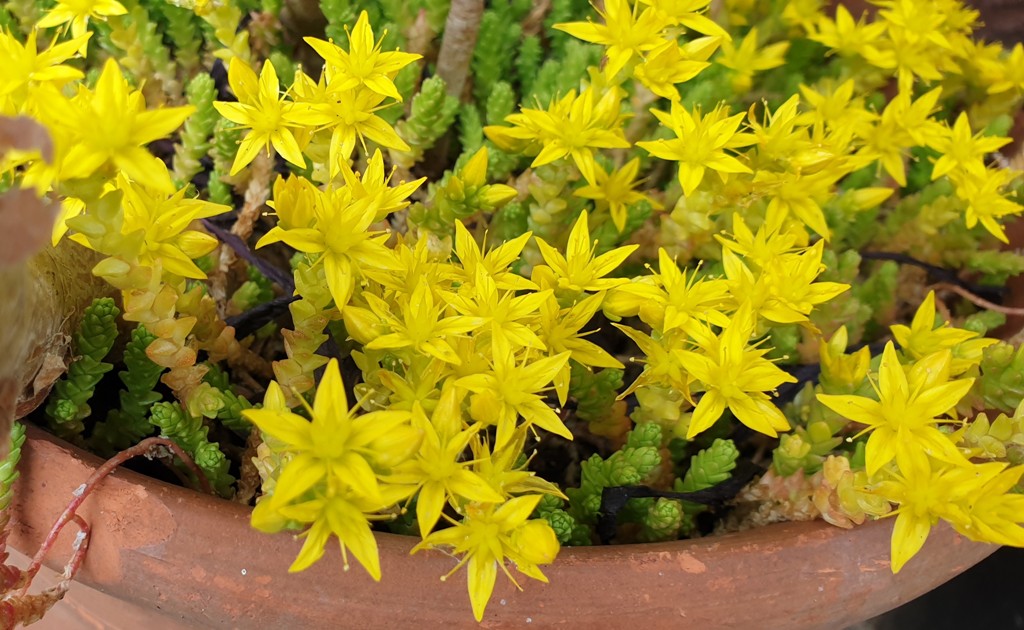
Sedum acre or Biting Stonecrop
A perennial herb of dry, undisturbed and open habitats on skeletal, or virtually non-existent, acidic or basic soils. Typical natural habitats include shingle, sand dunes, cliffs and steeply sloping, S.-facing rocks. It is also frequent on walls, roofs, gravel tracks, pavements and road verges.
Biting stonecrop spreads when allowed to do so, but is easily controlled, being shallow-rooted. It is used in hanging baskets and container gardens, as a trailing accent, in borders, or as groundcover. This plant grows as a creeping ground cover, often in dry sandy soil, and is a useful component on roof gardens.
The leaves contain an acrid fluid that can cause skin rashes.

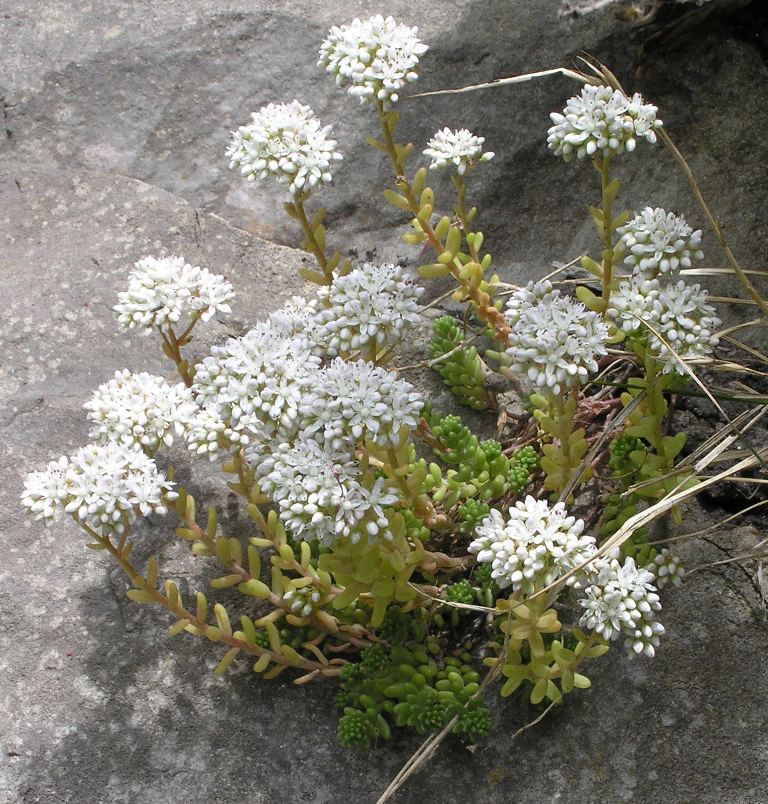
S. album or White Stonecrop
This creeping perennial herb grows on open, dry sites, such as limestone rocks, walls, roofs, the concrete of old airfield runways, maritime shingle, paths and gravel on graves. It is treated here as an alien, though some authors have suggested that it may possibly occur as a native on limestone rocks at the eastern end of the Mendips and in S. Devon.
Sedum album is able to acclimate to its environment. It can switch between C3 carbon fixation and crassulacean acid metabolism (CAM) depending on the availability of water. CAM saves water as the stomata on its leaves only open to allow CO2 to diffuse into the leaves at night when the temperature (and therefore evapotranspiration) is lower. Drought stressed plants are also more susceptible to photoinhibition which CAM may help to protect against.
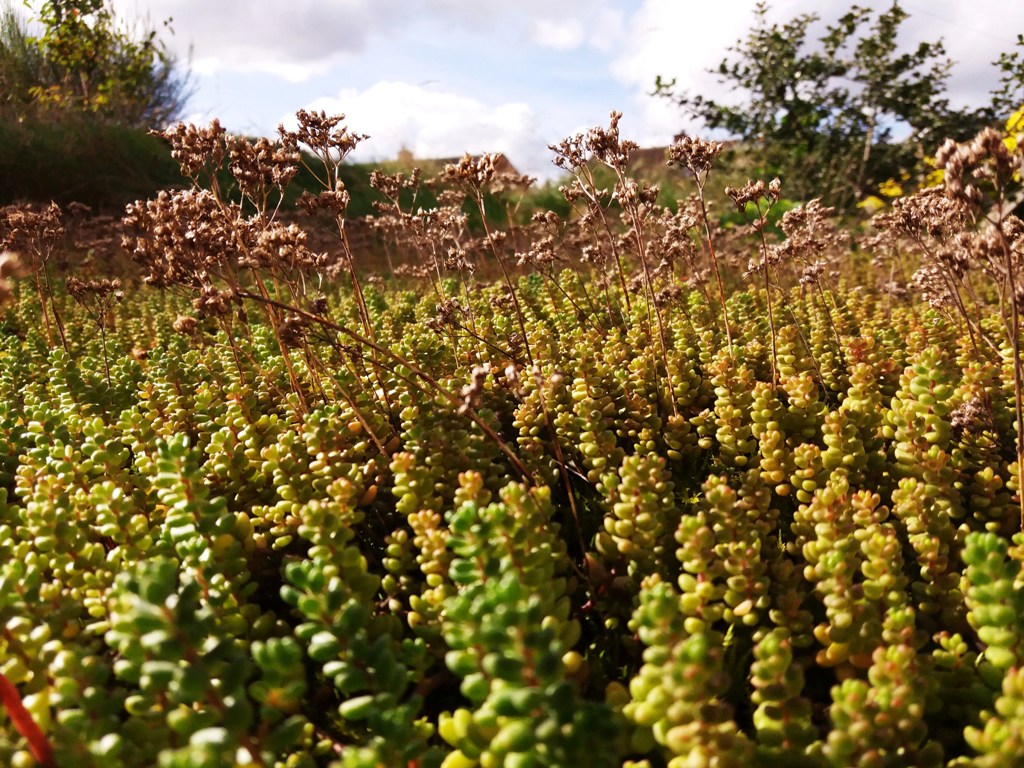
S. anglicum or English Stonecrop
This creeping perennial herb of base-poor substrates occurs on rocks, dunes and shingle, and is also known from dry grassland. It is a characteristic plant of open ground on acidic rock outcrops near the sea. It also grows on old walls, rocky hedge banks, and quarries and mine spoil on acidic substrates.
S. villosum or Hairy Stonecrop
A small biennial or perennial herb which grows in at least slightly base-enriched, wet, stony ground and on streamsides in hilly areas, and in montane, often bryophyte-rich, flushes.
S. praealtum or Greater Mexican-stonecrop
An evergreen sub-shrub, occurring as a naturalized garden escape on rocks, cliffs and banks; also an occasional relic of cultivation.
Ornamental and Medicinal Uses:
It can be used as a bonsai due to its treelike appearance and it bears a resemblance to the Jade plant. It easily grows in rock gardens in well-drained, poor soils.
A spermicide developed from this plant, that helps women control birth rates without any major side effects, was around 20% more effective than nonoxynol-9. Its leaf substance has been traditionally used for burns, hemorrhoids and dysentery, gum inflammation, and as well as an eye drop for conjunctivitis and irritations.
Petrosedum forsterianum or Rock Stonecrop
A mat-forming perennial herb of open, dry, well-drained habitats, including rocks and screes, wooded cliffs and gullies. Naturalised colonies are found in churchyards, on waste ground, mine waste, walls and railway land.
P. rupestre or Reflexed Stonecrop
P. sediforme or Pale Stonecrop
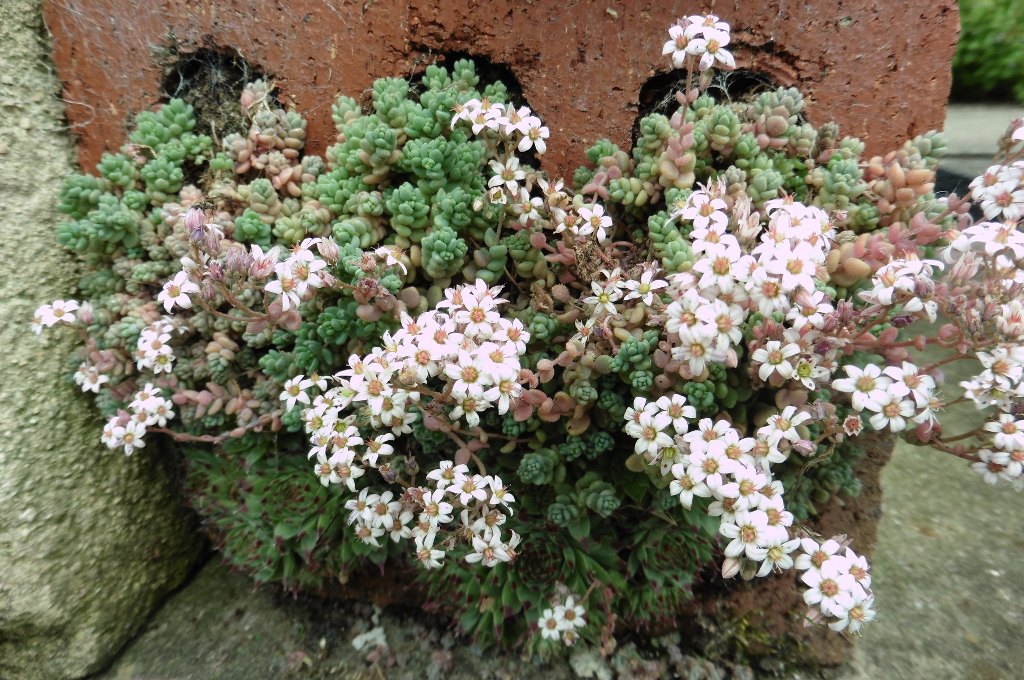
Sedum dasyphyllum or Thick-leaved Stonecrop
Several other species have been mentioned in the Online Atlas which are mostly attractive introduced species from gardens and a link is provided to learn more.
- S. anacampseros or Love-restoring Stonecrop
- S. hispanicum or Spanish Stonecrop
- S. kimnachii or Lesser Mexican-stonecrop
- S. lydium or Least Stonecrop
- S. spathulifolium or Colorado Stonecrop FBBC
- S. sexangulare or Tasteless Stonecrop FBBC
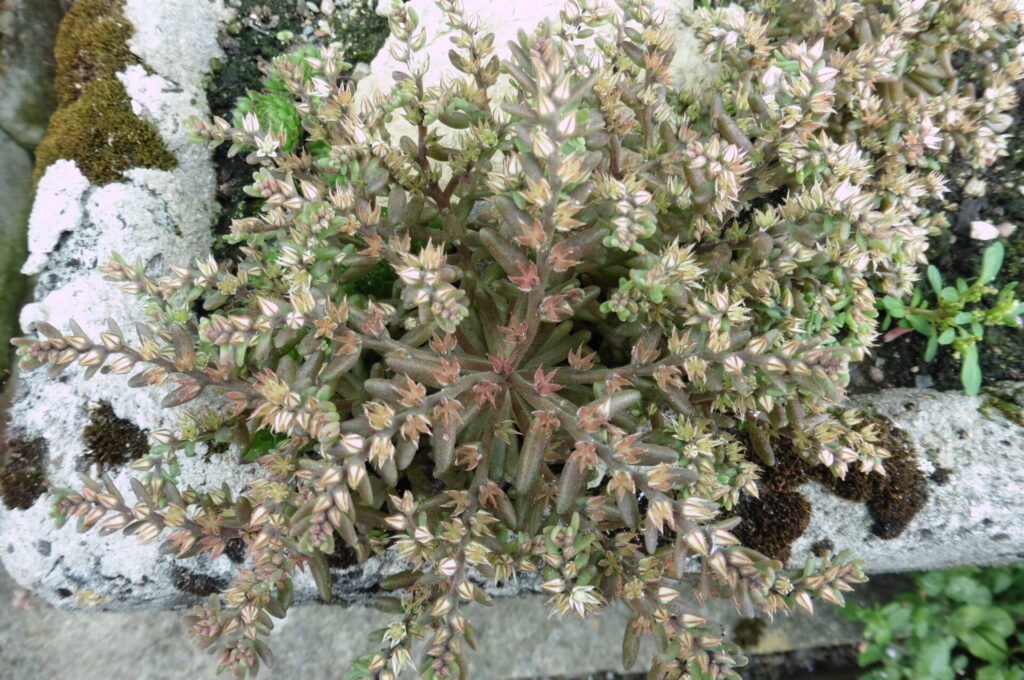
Phedimus stellatus or Starry Stonecrop (pictures by M. Poulton)
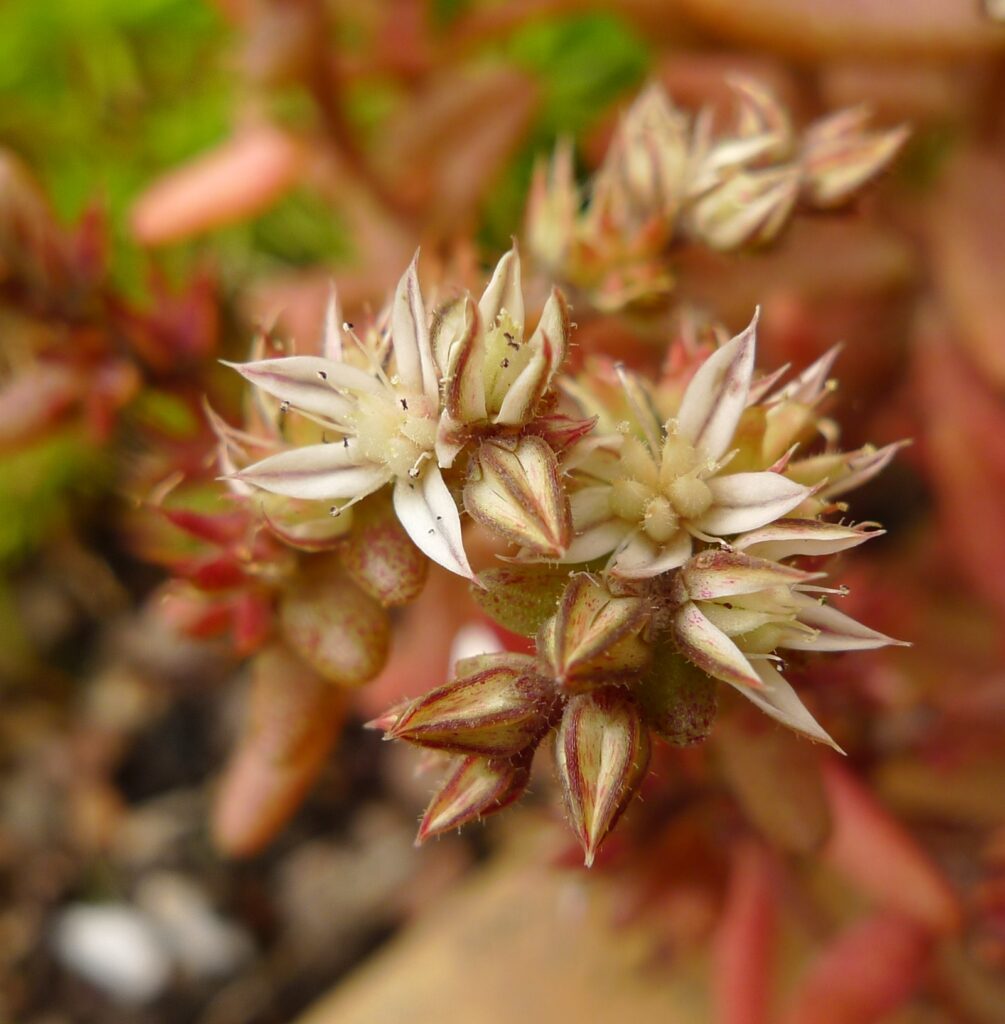
Phedimus stellatus or Starry Stonecrop
An annual herb, which is apparently not now grown in gardens, but was once established in open grassland; it spreads by seed.
Phedimus kamtschaticum or Kamchatka Stonecrop FBBC
A succulent, clump-forming perennial herb, grown in gardens and found as a relic of cultivation or a naturalized garden throw-out on roadsides, railway banks and waste ground. It is occasionally self-sown.
P. spurius or Caucasian-stonecrop FBBC
A winter-green, succulent perennial herb, with creeping stems, widely grown in gardens and found naturalized on walls, rocks, roadside banks, refuse tips and waste ground.
